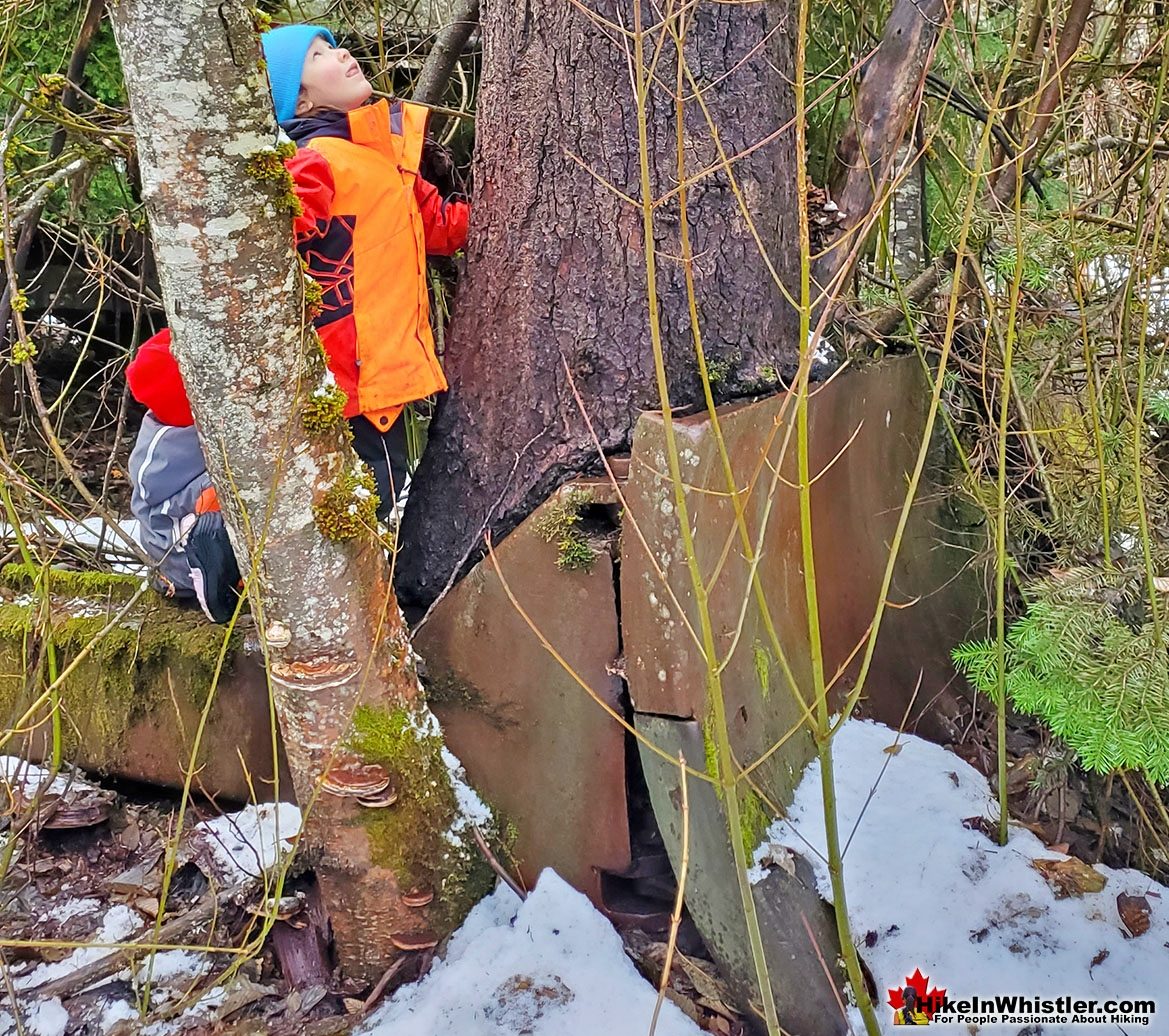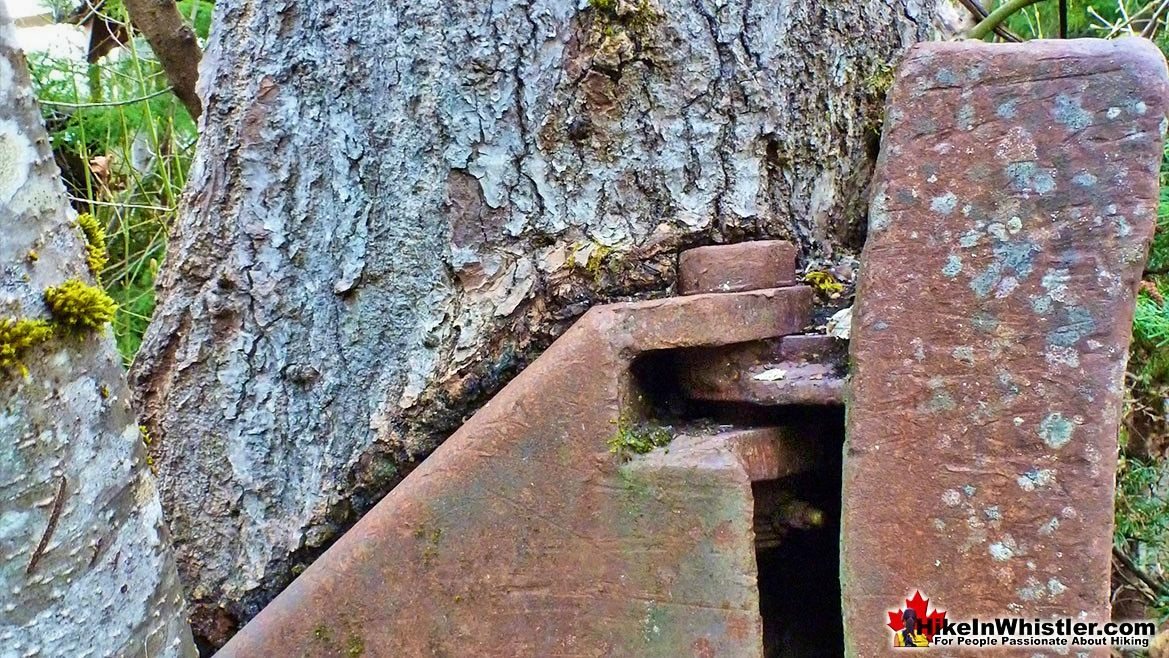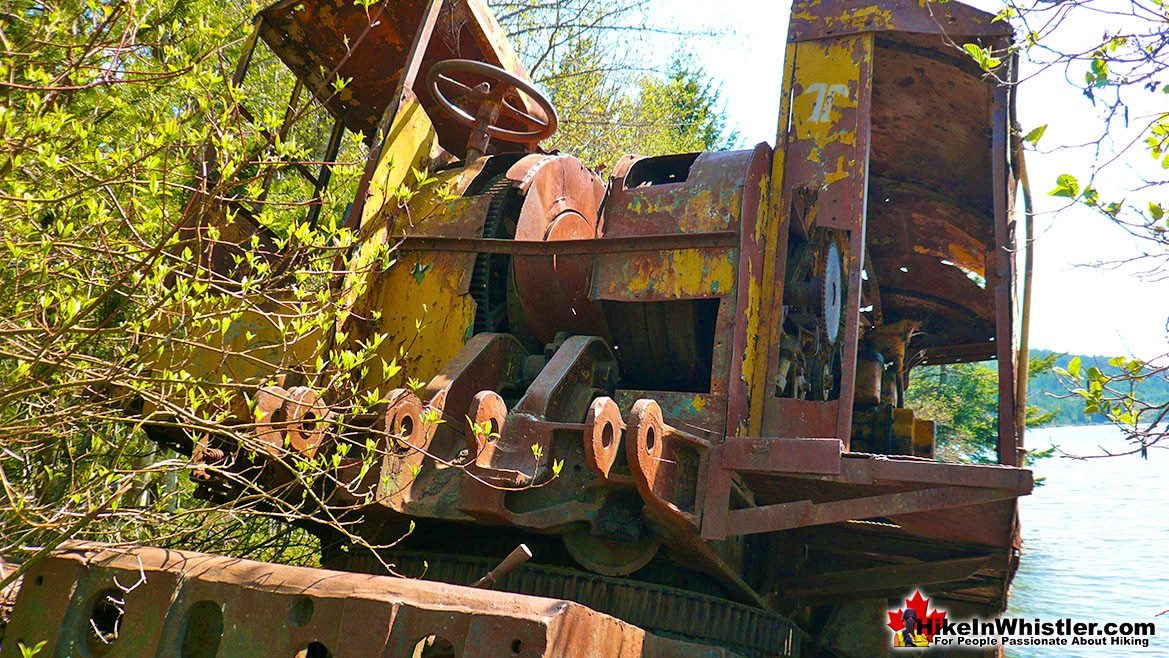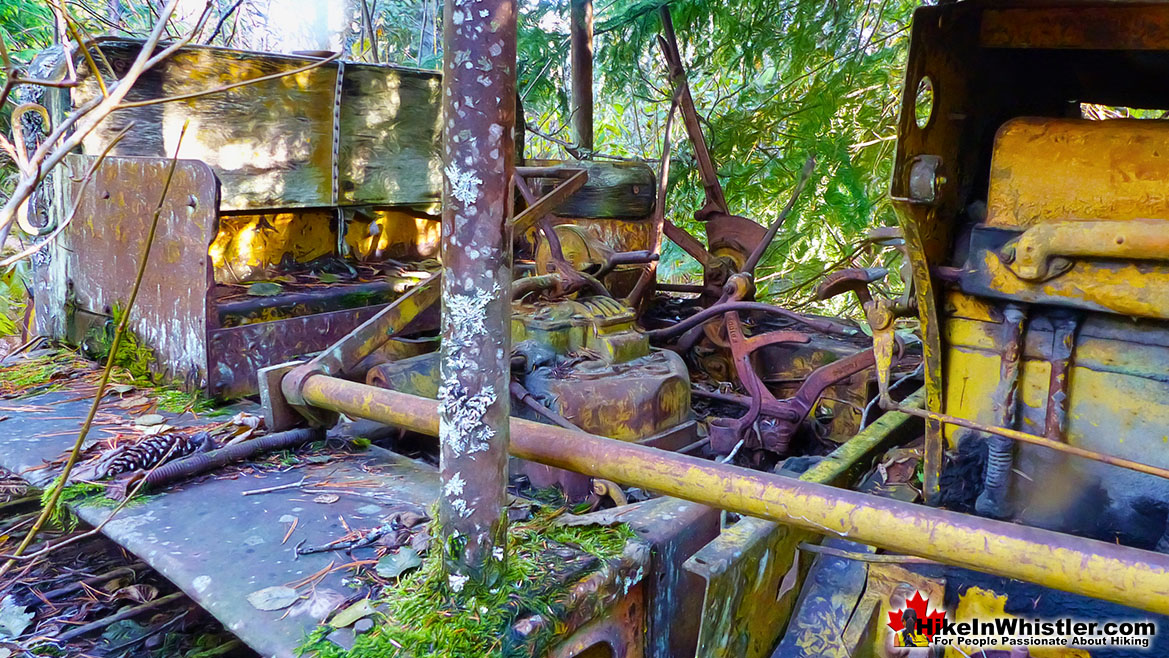
![]() Hidden in the tangle of forest along Green Lake where the old Parkhurst Sawmill once operated, is the bizarre and beautiful Parkhurst Plow Tree. A very large aspen has managed to grow, probably since 1956, through a big triangular gap in a huge, 4 ton steel tractor plow. Spilling over the top of the plow, the bark of the aspen has molded itself over the plow and has grown to a width about twice the size of the gap within the plow.
Hidden in the tangle of forest along Green Lake where the old Parkhurst Sawmill once operated, is the bizarre and beautiful Parkhurst Plow Tree. A very large aspen has managed to grow, probably since 1956, through a big triangular gap in a huge, 4 ton steel tractor plow. Spilling over the top of the plow, the bark of the aspen has molded itself over the plow and has grown to a width about twice the size of the gap within the plow.
Whistler & Garibaldi Hiking
![]() Alexander Falls
Alexander Falls ![]() Ancient Cedars
Ancient Cedars ![]() Black Tusk
Black Tusk ![]() Blackcomb Mountain
Blackcomb Mountain ![]() Brandywine Falls
Brandywine Falls ![]() Brandywine Meadows
Brandywine Meadows ![]() Brew Lake
Brew Lake ![]() Callaghan Lake
Callaghan Lake ![]() Cheakamus Lake
Cheakamus Lake ![]() Cheakamus River
Cheakamus River ![]() Cirque Lake
Cirque Lake ![]() Flank Trail
Flank Trail ![]() Garibaldi Lake
Garibaldi Lake ![]() Garibaldi Park
Garibaldi Park ![]() Helm Creek
Helm Creek ![]() Jane Lakes
Jane Lakes ![]() Joffre Lakes
Joffre Lakes ![]() Keyhole Hot Springs
Keyhole Hot Springs ![]() Logger’s Lake
Logger’s Lake ![]() Madeley Lake
Madeley Lake ![]() Meager Hot Springs
Meager Hot Springs ![]() Nairn Falls
Nairn Falls ![]() Newt Lake
Newt Lake ![]() Panorama Ridge
Panorama Ridge ![]() Parkhurst Ghost Town
Parkhurst Ghost Town ![]() Rainbow Falls
Rainbow Falls ![]() Rainbow Lake
Rainbow Lake ![]() Ring Lake
Ring Lake ![]() Russet Lake
Russet Lake ![]() Sea to Sky Trail
Sea to Sky Trail ![]() Skookumchuck Hot Springs
Skookumchuck Hot Springs ![]() Sloquet Hot Springs
Sloquet Hot Springs ![]() Sproatt East
Sproatt East ![]() Sproatt West
Sproatt West ![]() Taylor Meadows
Taylor Meadows ![]() Train Wreck
Train Wreck ![]() Wedgemount Lake
Wedgemount Lake ![]() Whistler Mountain
Whistler Mountain
![]() January
January ![]() February
February ![]() March
March ![]() April
April ![]() May
May ![]() June
June ![]() July
July ![]() August
August ![]() September
September ![]() October
October ![]() November
November ![]() December
December
Seemingly unbothered by the choke hold the plow has it in, the tree has grown to fill the absurdly elongated triangle shape of the plow. The tree is quite tall and fortunately for the aspen the plow is tremendously solid and heavy looking. Solid enough to shoulder the weight of big tree anchored awkwardly to it and swaying in winter storms. The first time you encounter this remarkable tree you wonder how it came to be abandoned here without some sort of tractor attached to it. It is at this point that you start to appreciate one of Parkhurst Ghost Town's extraordinary features. The rapidly growing forest hides things very effectively. In fact, you can have a good look at the amazing Plow Tree and not notice that about 3 metres away is an enormous Caterpillar tractor. So close in fact, that one of the metal arms from the Plow Tree is almost touching the Caterpillar's giant steel tracks. After ducking under the wall of bushes that blocked your view, you find yourself pressed up against a huge, old and surreal tractor frozen in time and consumed by trees. The 4000 kilogram plow is suspended off the ground about even with your knees and the old steel cable pulley system used to lift the plow is still intact. Back in the early days of tractors the engine powered a winch that pulled a cable stretched high above the front of the tractor on a metal frame. The thick metal cable is still hanging from the frame but it doesn't seem to be holding the weight of the plow and it looks to have come off the pulley and is just around the bar under the pulley.
The massive steel plow seems to be held up by several trees growing under it. You quickly discover after poking your head around and under the plow that the trees aren't holding up the plow, but more accurately lifting the plow. It looks like the plow is being wrenched upward by several trees growing underneath it.
Caterpillar RD8 Tractor in Parkhurst Ghost Town
The tractor attached to this tree levitating plow is a Caterpillar RD8, built in 1936 and left in this spot in 1956 when the Parkhurst Sawmill closed for good and Parkhurst was abandoned. Taking a closer look at the Caterpillar's plow and comparing it to the Plow Tree's plow, they look to have quite different features. The Plow Tree plow doesn't have the overhead cable attachment fitting, but rather has a smaller metal rocker arm attached to each arm on a hinge that looks to connect upward to an entirely different type of tractor. Maybe it belongs to the huge Caterpillar tractor perched on the edge of Green Lake just a few metres away and noticeably doesn't have a plow attached.
Though both these Caterpillar tractors are similar, both from the same 1H series of RD8 and D8 Caterpillars made from 1935 to 1941. This one in the forest next to the Plow Tree is a Caterpillar RD8 built in 1936 and the one on Green Lake is a Caterpillar D8 built in 1939. The Caterpillar D8 is a special parts design and is a log skidder and doesn't seem to be built to hold a plow and after another closer look at the Plow Tree plow, it doesn't appear to be designed for a Caterpillar tractor at all. Pictured below is the Caterpillar RD8 1H series Caterpillar tractor next to the Parkhurst Plow Tree.
Pictured below is the Parkhurst Plow Tree with the curious rocker arm that doesn't seem to be compatible with the Caterpillar RD8 1H series tractor next to it or the Cat D8 down at the shore of Green Lake.

What Tractor Fits the Plow Tree's Plow?
The answer it turns out is found just a few dozen metres away in the middle of the the thick forest that used to be the Parkhurst Sawmill. A little bushwhacking leads you to a third Parkhurst logging tractor. This tractor is a bit newer, probably made in the mid 1940's and a different brand of tractor called Cletrac. This Cletrac tractor, possibly a model D uses a very different style of plow with very long arms attached along the side of the tracks. On either side of the tractor each plow arm had another arm connected to it higher up with a hydraulic cylinder pushing a rocker arm to move the plow up and down. The Parkhurst Cletrac, though it is not immediately obvious as it it pushed up against big trees, is missing a plow. The Plow Tree's rocker arms look like they might fit to the piston arms of this old Cletrac. So the Plow Tree plow almost certainly belongs to the Parkhurst Cletrac that for some reason was separated from it when the town was abandoned. Pictured here is an old 1940's advertisement put out by Heil, a company that produced a lot of plows for Cletrac tractors in the 1940's.

Notice the way the plow is connected to the side of the tracks and also to the side of the tractor body with a hydraulic cylinder powering the plow up and down via the rocker arm. The old Parkhurst Cletrac is very similar to this one, though it is hard to tell with it buried in forest growth, many parts missing off the body, no plow attached. The left side of the old Cletrac is very tough to see with all the trees growing. The right side is much easier to access, but is missing the big plow attachment assembly and hydraulic cylinder. The picture below is the Parkhurst Cletrac's left side very obscured by trees. You can see a bit of the plow attachment assembly on the side of the tracks and up to the side of the tractor body as well as the hydraulic cylinder leading to the rocker arm attachment that likely fits to the Plow Tree's rocker arm connected to the plow.
What Kind of Tree is the Parkhurst Plow Tree?
The Parkhurst Plow Tree is impressive to see up close and leaves you wondering how a tree can grow so tall when confined to such a small and unnaturally shaped opening. The old aspen tree, assuming it began growing shortly after the plow was abandoned, is about 65 years old. Aspen trees are usually recognizable from their thin white bark, though old aspen trees develop bark that is old looking, cracked, furrowed and brown in colour. The other tree in the picture below appears to be a younger aspen tree and has the more recognizable white bark.

A closeup view of the Plow Tree shows the solid bolt connection on the old Heil plow. A considerable amount of weight is pushing down on the blade of the plow and this big bolt connection. These old mid nineteenth century plows usually weigh well over 4000 kilograms.


A closer look at the roughly triangular opening in the Heil plow that confines the seemingly unhindered Plow Tree. From this angle you would almost expect the plow to be lifted by the tree as the plow has been on the Caterpillar a couple metres away. Maybe it takes several trees forcing their way upward from various opposing points on a plow to lift it up and the single tree growing through this plow was not strong enough. It might also be that the neighbouring Caterpillar already had its plow suspended off the ground when abandoned, which allowed several trees to get a start growing underneath. Hard to tell after so many years, but judging by the minimal slack on the cables today, that the trees may have only lifted it part of the 40 or so centimetres off the ground. Regardless, lifting a 4 ton plow is impressive even if the trees had a head start. The Plow Tree evidently has been laying flat on the ground since the aspen began growing in 1956.

Looking from a lower angle at the Plow Tree and it does appear to be off the ground a little, though it looks to be from the plow blade and probably not the tree pushing upward. Funny to think that this entire area was flat with no trees, a few buildings and probably a layer of gravel when this plow originally was dropped here over six decades ago.


It takes a person standing next to the Plow Tree to appreciate how big the plow is and how large the tree growing through it is. The bark squeezing over the top of the plow blade is very visible on the picture here.

Unstable Ground for Trees in the Peninsula
The Plow Tree is quite tall compared to most of its neighbours. With an unusually large amount of fallen trees in the land that was once the Parkhurst Sawmill might be caused by a thick layer of gravel and sand that covered the area as shown in the old pictures of Parkhurst. The trees may not have a very stable, packed down forest floor to grown from. Growing through the sturdy old plow may have and still provide stability to this tree to outlive other trees in the forest here. An intensive study of sedimentation patterns in Green Lake done in the early 2000's by Erik Schiefer found that the peninsula where the various incarnations of Parkhurst Sawmill were built was largely composed of sand and gravel fill material. Various core samples taken from the bottom of Green Lake show distinct layers of sawdust that exactly coincide with the historical record of Parkhurst. Starting in the late 1920's some sawdust appears and gradually increases until an abrupt stop in 1938 when the sawmill burned down and for a short time moved to Lost Lake. The mill was rebuilt at Parkhurst in 1939 and the cores show sawdust concentrations slowly increasing into considerably amounts in the 1940's and 1950's until they abruptly stop in 1956 when the mill was permanently closed.

Below is a picture of the Parkhurst Sawmill in the 1950's. The plow would have been abandoned in the far left clearing in the picture and the old Cletrac tractor was abandoned about where the truck is located. Except for the stacks of wood, this is pretty close to what the sawmill would have looked like when it was abandoned. That old truck may be one of the trucks abandoned in Parkhurst. The huge steel smokestack can still be found in the forest and most of the sheet metal roofs are buried under a layer of forest floor here.
Parkhurst Sawmill
The Parkhurst Sawmill operated on the triangle of land that juts out into Green Lake and also extended along the shore between the train tracks and the shore. The old sawmill was almost certainly crushed under heavy snow in the years following its closure in 1956. With the town abandoned there were no caretakers to maintain any of the old structures and the crushing weight of spring snow eventually flattened all but two of the old houses and the old sawmill.
Today, when you wander around where the old sawmill was you will notice a strange lack of trees growing in certain areas. After a bit of poking around you realized that under the forest floor layer of dirt, moss and grass are huge sheets of metal that once covered the roof of the Parkhurst Sawmill. Some of these can still be seen where there once was a covered area over train tracks that branched off from the railway we see today and extended to the sawmill near the end of the point of land. With some digging you may uncover the old train tracks under all the collapsed debris, but it seems likely that the tracks were removed and salvaged. The giant steel chimney from the sawmill is still easy to find sprawled across the forest floor in a few pieces. The brick building that housed the furnace is now a pile of bricks crumbling around the old furnace. Also in the forest you will encounter yet another abandoned tractor. An old Cletrac tractor, similar to the the Caterpillar RD8, but newer, smaller and lacking an enormous plow. As with the Caterpillar RD8, the forest has consumed and hidden it quite well.
Parkhurst Ghost Town
Parkhurst Ghost Town is a beautiful and comparatively quiet place to hike in Whistler. An ever increasing network of hiking and biking trails over the years have made it quite an accessible place to get to from either the Sea to Sky Trail/Green Lake Loop Trail from Lost Lake near Whistler Village or via the Parkhurst Trail at the far end of Green Lake. A short drive from Whistler Village along the Sea to Sky Highway past the north end of Green Lake takes you to the trailhead for the Parkhurst Trail and the short hike to Parkhurst. The highlights of Parkhurst Ghost Town are not just the interesting old relics of the abandoned town, but the gorgeous views of Green Lake from several places along the Parkhurst Ridge Trail.
More Parkhurst Ghost Town Info
More Whistler & Garibaldi Park Hiking A to Z!







The Best Whistler & Garibaldi Park Hiking Trails!




Whistler & Garibaldi Park Best Hiking by Month!




Explore BC Hiking Destinations!

Whistler Hiking Trails

Squamish Hiking Trails

Vancouver Hiking Trails

Clayoquot Hiking Trails

Victoria Hiking Trails















